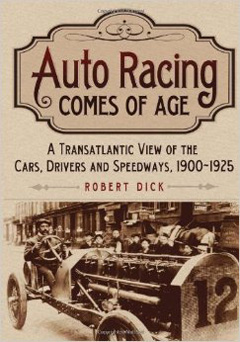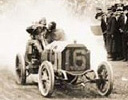Book Review
by Russell Jaslow
Auto Racing Comes of Age
by Robert Dick
McFarland
800-253-2187
ISBN: 978-0-7864-6670-2. List Price: $75.00.
  The author set out to provide the history of the evolution of European and American auto racing from 1900 to 1925, examining transatlantic influences, early dirt racing, and the birth of the twin-cam engine and the straight-eight. From a technical standpoint, he succeeded, which is not surprising since Robert Dick is a historian in mechanical engineering and automotive matters. The author set out to provide the history of the evolution of European and American auto racing from 1900 to 1925, examining transatlantic influences, early dirt racing, and the birth of the twin-cam engine and the straight-eight. From a technical standpoint, he succeeded, which is not surprising since Robert Dick is a historian in mechanical engineering and automotive matters.
This burgeoning era of the automobile saw leaps and bounds in technology, most of it led by the manufacturers and independents involved in racing their innovations. The contributions of Mercer, Marmom, Miller, Stutz, Mason, Duesenberg, Delage, Ballot, Peugeot, FIAT, Mercedes, and Bugatti, amongst others, are all covered in detail.
Dick explains how we got from one particular engine to another, and the influences each change had on subsequent inventions. This includes the influence each side of the Atlantic had on each other, especially when teams crossed the ocean to compete in the major events of the day, such as the Gordon Bennett Cup, Brooklands, Vanderbilt Cup, United States Grand Prize, Indianapolis 500, and the European Grands Prix, especially the French Grand Prix. This cross-pollination allowed each side to see and adopt the best of the other.
There was also a lot of cross-pollination between companies, as many times the top technical folks from one company would be lured to another, thanks to the tried and true methods of money, promotion, and promising more control. The book explains how these personnel movements affected the technological growth of the sport.
If you are one who loves the technical aspects of auto racing, you will love this book. It provides a lot of the answers from a technical viewpoint a lot of other books fail to answer concerning the early advances of engines. Dick does cover to some degree gearboxes and chassis design, but the brunt of his technical focus is on engines.
On the flip side, if you are looking for the same type of coverage of this time period of the races, tracks, and drivers, the book falls short, despite claiming equal coverage across the gamut of subjects. He does present chapters specifically for some of these subjects, but they tend to continue the technical look at the sport.
There are other books which do a better job covering these subjects for the early history of auto racing. However, Dick does provide some wonderful anecdotes of drivers, and sometimes the races and companies, which have never been reported before. For these gems, the book was enjoyable for that aspect as well.
This book is extremely well researched, with proper footnoting. Dick used all sorts of sources to put this treatise together. As Donald Davidson of the Indianapolis Motor Speedway said, proper researching means getting your hands and knees dirty digging through archives, not just surfing the Net. This book qualifies under that definition of proper research.
Therefore, the book also contains worthwhile appendices. My favorite, in fact one of my favorite for any book I've read, is Appendix C: Riding Mechanics. Dick provides the list of riding mechanics for many of the major races of that day. This is a subject which has been so difficult for many to assemble. Though there are still gaps in names, it is the most comprehensive list I've seen anywhere. Dick is to be commended for this effort.
Other appendices include Biographical Data (I would have liked to see a bit more detail here instead of just birth and death dates), Technical Data (the motorhead readers will feel like a kid in a candy store), as well as the Notes and Bibliography sections.
The book may not be a page turner and there are gaps in the history of drivers and speedways, but for the technical coverage of the cars and engines of the dawn of auto racing, it has a much needed place on the library shelf for this time period.
Copyright © 2013 by . All Rights Reserved.
|



